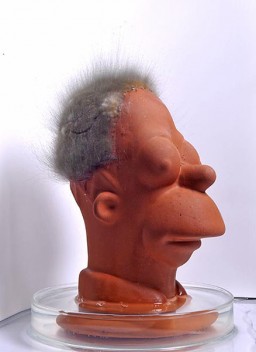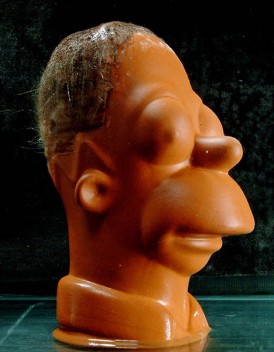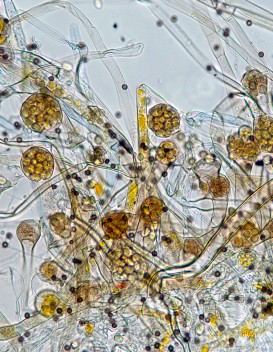New Growth: Hairy Homer
Things have been quiet here since March–that’s when everything went haywire behind the scenes. Doh!!! I was unable to create new blog posts (with one minty exception) and got a surprise dunking in the dunk tank of university bureaucracy, here represented by the metaphor of Homer Simpson’s head. In recent months, I had simple goals: 1. Fix the blog. And 2. Grow some hair on Homer’s head. I was unprepared for the hours, patience, and sheer grit these modest goals would demand.
We began with a Chia Pet.™ If you were not alive in 1980s North America, you need a Chia Pet primer. You might wish to watch the original Chia Pet advertisement so that the Chia earworm gets stuck in your head: ch-ch-ch-chia! Perfectly normal people buy these terra cotta statuettes, fill them with water, and smear them with the sticky seeds of the Chia plant. Over the next week or so the Chia Pet grows a sprouty green coat. We are not perfectly normal. We thought our Homer Simpson Chia Pet would be better with actual hair that would grow on its own. Since this hasn’t been invented yet, we used a handy fungus.
Phycomyces blakesleeanus is a fantastic fungus. It doesn’t do much except grow on poop and other rotting stuff, but it is a staple in most Intro Mycology classes for a few reasons. It is harmless, and it is big and tall, as required for a good toupee. It’s had its genome sequenced, which imparts a certain nobility. It can sense and respond to light, touch, gravity, and other stuff. And it will have kissy, spiky sex in the lab when introduced to a compatible partner (!). Those hairs it makes are its sporangiophores, each of which holds aloft a tiny sphere full of spores.
 Just as fixing a blog in the heady atmosphere of academia isn’t quick, so went our hairy Homer project. First, unlike Chia plants, which make their own food from thin air and light, a fungus needs something for lunch. We made it a lunch of potato dextrose broth with a heavy dose of agar, and the indefatigable Dave Kalb applied it to Homer’s bald pate while still warm. Dave says, “I held the base of Homer with my hand to accomplish this. He was situated and turned as needed to cover his head with agar where we wanted “hair” but not to allow drips where we did not want “hair”, like his eyes and nose… Next, chunks of agar from a plate containing actively growing Phycomyces blakesleeanus were blotted onto the agar on Homer’s head. This was repeated several times to ensure all areas were covered.” Then we filled Homer up with water and filmed him patiently while various things went wrong.
Just as fixing a blog in the heady atmosphere of academia isn’t quick, so went our hairy Homer project. First, unlike Chia plants, which make their own food from thin air and light, a fungus needs something for lunch. We made it a lunch of potato dextrose broth with a heavy dose of agar, and the indefatigable Dave Kalb applied it to Homer’s bald pate while still warm. Dave says, “I held the base of Homer with my hand to accomplish this. He was situated and turned as needed to cover his head with agar where we wanted “hair” but not to allow drips where we did not want “hair”, like his eyes and nose… Next, chunks of agar from a plate containing actively growing Phycomyces blakesleeanus were blotted onto the agar on Homer’s head. This was repeated several times to ensure all areas were covered.” Then we filled Homer up with water and filmed him patiently while various things went wrong.
We’ve re-haired Homer 6 times now. People got used to us carrying Hairy Homer down the hall, his semi-luxuriant hair waving in the breeze. Nothing surprises a plant pathologist! You can see the things that went wrong in our hirsute bloopers gallery below. We think our final video looks pretty good but people, we are so DONE with this now. We are considering marketing our Practically Instant Hair Growth Potion. It might itch a bit.
The blog is fixed now too, and hopefully it looks about the same to you, but under the hood it has been spiffed up– ta da! Meanwhile, photographer Kent Loeffler and his intern Claire Smith have been moving our popular quicktime video collection over to YouTube. Now you can see our funky fungal time lapse movies on the new Cornell Plant Pathology Photo Lab channel.
It’s been six years since my first post. I like this blog, and I hope you do too. I’ll post more fungusy stuff soon. Send me a note so I know you’re out there; tell your friends; correct my mistakes. Buy our new hair product… New blog. New hairdo. It’s a good day.
Hairy Hairy Homer Outtake Gallery
Recall, each time we tried this, we had to scrub and sterilize Homer’s head. Dave had to prepare the magic hair-growing goop and coat Homer’s scalp, then inoculate him with Phycomyces–you’d pay hundreds for this in a good salon. We had to set Homer up in a humid tank and take photos of him behaving badly over a week or so. Sooooo, all these bloopers were a bit of a bummer:
- 1. Homer dried up: unhappy fungus.
- 2. Homer got too wet: he dripped and grew a moldy brow.
- 3. Homer’s looking pretty good! But now that we’ve mastered this, we thought, we could improve the lighting…
- 4. Homer had a bad hair day (week). It happens.
- 5. An evil green parasitic mold called Trichoderma ate our fungus! Sigh.
- 6. Against his scalp, we found the less luxuriant microsporangia of Phycomyces.
Dave Kalb and Kent Loeffler worked hard to make Homer hairy. A number of Cornell elves worked hard, surviving on nothing but coneflowers, so that we could have our blog back–thank you so much, blog elves. And the very talented Claire Smith interned this Summer in the Plant Pathology Photo Lab–she got our YouTube Channel going, and spiffed up each of the videos there. More are on the way.
- Benjamin, C. R., and C. W. Hesseltine. 1959. Studies on the genus Phycomyces. Mycologia 51:751-771.
- Johnson, D.L. and R. I. Garnow. 1971. The Avoidance Response in Phycomyces. Journal of General Physiology 57: 1 41-49.
What to do with all the unneeded Chia seeds? Make chia pudding, of course.








your blog is wonderful! thanks for posting.
daishin
Glad you are back! Thanks for the entertaining and informative post!
Hurray! You’re back! Just in time for mushroom season (if we get any rain).
Pretty neat. The post was forwarded to me via the AMC blog. When I taught high school ecology we grew wild strain Pilobolus cultures on horse dung as part of succession labs. I always described it as as a Chia Pet or Bart’s hair. Good to know like minds exist in the land of Tom Eisner!!
Good to have the bodacious blog back. Hommie looks quite aged in Trichoderma hair or maybe how he’d look as a street person. What fungus could produce Marge’s hair?? I Love the blog. Missed the blog. Glad I got my babyback blog back. I look forward to more….
Thanks for the sweet comments, blogfriends. Maybe we could do Marge with this Chaetomium, on a slightly smaller scale…
I’m so glad I found this blog! I’ve become intrigued by the fungus world since recently reading Paul Stamet’s Mycelium Running (which I LOVED) and I discovered this blog when I googled ‘mycology fiction’ and saw the post here on the novel Spiral, which I am now checking out at the library. Looking forward to keeping up with the blog!